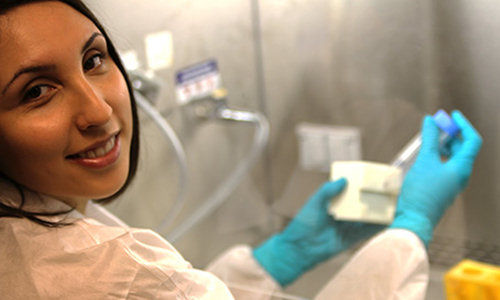Second-year bioengineering doctoral student Sylvia Natividad-Diaz may have found a way around a persistent obstacle in the treatment of HIV/AIDS—identifying when an HIV-positive patient’s condition is worsening before irreversible symptoms are evident. Having that information allows health care providers to deliver the right medications at the right time, leading to better outcomes.
To address the problem, Natividad-Diaz developed a handheld cell counter the size of a Rubik’s Cube that’s affordable and easy to use. It doesn’t require electricity and can provide results on the spot. The device relies on a large rare-earth magnet to pull cells that have been labeled with magnetic microbeads out of a blood sample for further analysis.
Making such a device available in the remote, low-income regions where HIV is most prevalent—ideally for less than $200 per unit, she says—could be a game-changer.
At the end of 2012, 35.3 million people were living with HIV/AIDS worldwide. That number is on the rise, up from roughly 34 million in 2011, according to the World Health Organization. Yet deaths from the disease are actually declining (down to 1.6 million in 2012), thanks in part to antiretroviral therapy, a treatment that slows the progression of HIV.
Still, it’s not always effective. In order for antiretroviral therapy to work, clinicians must administer the proper dosage. One way to do this is by monitoring the content of CD4 cells (also known as T-helper cells) in the patient’s blood. These white blood cells play a critical role in the immune system—when they’re depleted, which happens as HIV advances, the body is less able to fight infections.
Existing instruments for monitoring these cell counts, however, are expensive, complex and not easily portable. The gold-standard method, flow cytometry, requires a device that costs up to $200,000, can be operated only by trained staff in a clinical setting and takes up to a week to deliver results.
Many countries with the highest rates of HIV—including Swaziland, Botswana and Lesotho, where around a quarter of all adults have the disease—are also among the world’s poorest. This has led to a bottleneck in the effective treatment of HIV/AIDS, limiting patients’ access to potentially life-saving drug therapy.
“It’s great to get medicine out to all these countries, but you need to give it properly,” Natividad-Diaz says. “Health care providers in resource-limited settings need to know when to initiate treatment in asymptomatic patients based on their CD4 counts,” otherwise they risk continued immunosuppression and further spread of HIV infections.
Natividad-Diaz can fit her latest prototype, fabricated with a 3D printer, in the palm of her hand: a simple, solid-white cube measuring 2x2x3 inches, with a slot for inserting a slide containing the patient’s blood sample. Inside, magnetic microbeads capture and sort the target cells (a technology she first developed by modifying an inkjet printer to output cell samples onto magnet-backed slides). Cell counts can then be read via a tabletop microscope—or with the CellScope, the cell phone microscope designed by Berkeley bioengineering professor Dan Fletcher and his students.
Natividad-Diaz is now finalizing a model of her device, which she plans to complete by the end of the academic year. One key feature is the ability of the device to integrate with a smartphone, which can facilitate imaging, image analysis and data management. She hopes to attain accuracy that is comparable to a flow cytometer and sufficient enough to provide clinicians with the data they need to make informed treatment decisions.
Even one of her earliest prototypes was groundbreaking enough to earn second place in the Student Technology Prize for Primary Healthcare last summer. Sponsored by Boston’s Center for Integration of Medicine and Innovative Technology (CIMIT) with Massachusetts General Hospital’s “Ambulatory Practice of the Future” clinic, the awards are granted to engineering students nationwide who develop technological innovations with the potential to improve care while reducing costs.
Natividad-Diaz’s award came with a $100,000 prize, which she reinvested in the project by hiring five undergraduates for hands-on lab work. Meanwhile, she is focusing on her doctoral dissertation, in which she aims to incorporate stem cells in a biomimetic material to promote cardiac tissue regeneration. (She calls the HIV monitoring device a “side project.”)
Later this year, Natividad-Diaz will field test her device in South Africa with clinicians on the front lines of the epidemic. If all goes well, by next March they’ll be sending devices to clinics throughout Africa to begin additional point-of-care testing. In another year, Natividad-Diaz hopes to bring it to market—an accelerated schedule motivated by what first attracted her to bioengineering. “I felt like I wanted to do something where I could directly impact people’s well-being, and that’s where bioengineering came into play,” she says.
In the eyes of her adviser and bioengineering department chair Kevin Healy, she’s well on her way. “It was a really good idea, and it just sort of lit fire,” he says. “It’s taking off with a lot of enthusiasm. It’s a great project, and hopefully we can deliver something that’s useful.”
Story Source:
The above story is based on materials provided by Innovations Berkeley.





